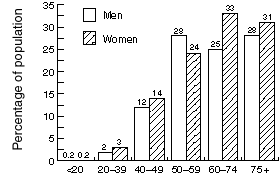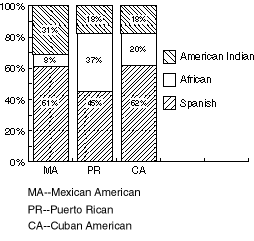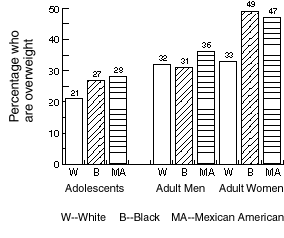- What Is Diabetes?
- Major Studies of Diabetes in Hispanic Americans
- How Many Hispanic Americans Have Diabetes?
- What Factors Increase the Chance of Developing Type 2 Diabetes?
- How Does Diabetes Affect Hispanic Young People?
- How Does Diabetes Affect Hispanic Women During Pregnancy?
- How Do Diabetes Complications Affect Hispanic Americans?
- Addressing the Problem of Diabetes in Hispanic Americans
- Points To Remember
- References
Diabetes in Hispanic Americans is a serious health challenge because of the increased prevalence of diabetes in this population, the greater number of risk factors for diabetes in Hispanics, the greater incidence of several diabetes complications, and the growing number of people of Hispanic ethnicity in the United States.
The following statistics illustrate the magnitude of diabetes among Hispanic Americans:
- In 1998, of the 30 million Hispanic Americans, about 1.2 million had been diagnosed with diabetes.
- About 675,000 Hispanic Americans have diabetes but do not know they have it. Identifying these undiagnosed cases and providing medical care for their diabetes is a major challenge for the health care community.
- Diabetes is particularly common among middle-aged and older Hispanic Americans. For those age 50 or older, about 25 to 30 percent have either diagnosed or undiagnosed diabetes.
- Diabetes is two to three times more common in Mexican American and Puerto Rican adults than in non-Hispanic whites. The prevalence of diabetes in Cuban Americans is lower, but still higher than that of non-Hispanic whites.
- As in all populations, having risk factors for diabetes increases the chance that a Hispanic American will develop diabetes. Risk factors seem to be more common among Hispanics than non-Hispanic whites. These factors include a family history of diabetes, gestational diabetes, impaired glucose tolerance, hyperinsulinemia and insulin resistance, obesity, and physical inactivity.
- Higher rates of the diabetes complications nephropathy (kidney disease), retinopathy (eye disease), and peripheral vascular disease have been documented in studies of Mexican Americans, whereas lower rates of myocardial infarctions (heart attacks) have been found.
What Is Diabetes?
Diabetes mellitus is a group of diseases characterized by high levels of blood glucose. It results from defects in insulin secretion, insulin action, or both. Diabetes can be associated with serious complications and premature death, but people with diabetes can take measures to reduce the likelihood of such occurrences.
Most Hispanic Americans with diabetes (about 90 to 95 percent) have type 2 diabetes. This type of diabetes usually develops in adults and is caused by the body's resistance to the action of insulin and to impaired insulin secretion. It can be treated with diet, exercise, diabetes pills, and injected insulin. A small number of Hispanic Americans (about 5 to 10 percent) have type 1 diabetes, which usually develops before age 20 and is always treated with insulin.
Diabetes can be diagnosed by three methods:- A fasting plasma glucose test with a value of 126 milligrams/deciliter (mg/dL) or greater.
- A nonfasting plasma glucose value of 200 mg/dL or greater in people with symptoms of diabetes.
- An abnormal oral glucose tolerance test, with a 2-hour glucose value of 200 mg/dL or greater.
Each test must be confirmed, on another day, by any one of the above methods. The criteria used to diagnose diabetes were revised in 1997.1
Major Studies of Diabetes in Hispanic Americans
Five population studies conducted in the past 20 years provide the majority of information that exists about the incidence and progression of diabetes among Hispanic Americans. The five studies are briefly described below:
- The Starr County Study (Texas) conducted in 1981 assessed the prevalence of severe hyperglycemia (high blood glucose levels) in almost 2,500 people age 15 or older. 2
- The San Antonio Heart Study (Texas), begun in 1979 and still being conducted, assessed diabetes in more than 3,000 Mexican Americans and almost 2,000 non-Hispanic whites between the ages of 25 and 64. 3
- The San Luis Valley Diabetes Study (Colorado), a continuing study that began in 1984, estimated the prevalence of diabetes in Hispanics and non-Hispanic whites in two counties in southern Colorado. 4
- The Hispanic Health and Nutrition Examination Survey (HHANES), 1982-84, investigated the prevalence of diabetes in national samples of the three major Hispanic subgroups--Mexican Americans in the southwestern United States, Puerto Ricans in the New York City area, and Cuban Americans in south Florida. Approximately 6,600 people participated. 5
- The Third National Health and Nutrition Examination Survey (NHANES III), 1988-94, determined the prevalence and characteristics of people with diabetes in national samples of African Americans, Mexican Americans, and whites. Approximately 18,000 adults participated. 6
How Many Hispanic Americans Have Diabetes?
Hispanic Americans are the second-largest and fastest growing minority group in the United States. In 1998, there were 30 million Hispanics in the United States, representing 11 percent of the population. By the year 2050, it is estimated that Hispanics will number 97 million and constitute 25 percent of the U.S. population.7
Mexican Americans represent the largest Hispanic American subgroup, with 64.3 percent of the Hispanic population. Central and South Americans represent the second-largest Hispanic American subgroup, with 13.4 percent of the Hispanic population.8 The majority of Hispanic Americans live in the south-central and southwestern United States.
Table 1 provides a list of Hispanic subgroups, the percentage of the Hispanic population they each represent, and the percentage of the population that has diabetes for two age ranges.
Figure 1 shows the prevalence of diabetes in Mexican American men and women based on the most recent national study, the NHANES III survey conducted in 1988-94.6 The proportion of the Mexican American population that has diabetes (defined by medical history or fasting plasma glucose of 126 mg/dL or greater) rises from less than 1 percent for those younger than 20 to as high as 33 percent for women age 60 to 74. In almost every age group, prevalence is higher among women than men.
About one-third of total diabetes among Hispanic Americans is undiagnosed. This is similar to the proportion for other racial/ethnic groups in the United States. 6
Prevalence in Hispanic Americans is much higher than in Americans without Hispanic ancestry. Among those age 40 to 74 in the 1988-94 survey, the rate was 11.2 percent for non-Hispanic whites, but 20.3 percent for Mexican Americans--in other words, the prevalence of diabetes in Mexican Americans is 1.8 times higher than in non-Hispanic whites. 6
| Table 1. Hispanic American Populations in the United States and Percentage With Diabetes | ||||
| Hispanic American population | % of total Hispanic population | Year of study | % with diabetes, age 20-44 | % with diabetes, age 45-74 |
| Mexican Americans | 64.3 | 1982-84 | 3.8 | 23.9 |
| Mexican Americans | 64.3 | 1988-94 | -- | 26.2 |
| Central/South Americans | 13.4 | -- | -- | -- |
| Puerto Ricans | 10.6 | 1982-84 | 4.1 | 26.1 |
| Cuban Americans | 4.7 | 1982-84 | 2.4 | 15.8 |
| Other Hispanic groups | 7.0 | -- | -- | -- |
| -- No data available. | ||||
Note: In this table, diabetes is defined using earlier guidelines by a medical history of diabetes or a diabetic oral glucose tolerance test (fasting glucose of 140 mg/dL or greater or 2-hour glucose of 200 mg/dL or greater). | ||||
| Figure 1.
SOURCE: Reference 6 Note: Diabetes includes both previously diagnosed diabetes and undiagnosed diabetes (fasting plasma glucose of 126 mg/dL or greater). |
What Factors Increase the Chance of Developing Type 2 Diabetes?
The frequency of diabetes in Hispanic American adults is influenced by the same risk factors that are associated with type 2 diabetes in other populations. Two categories of risk factors increase the chance of developing type 2 diabetes. The first is genetics. The second comprises medical and lifestyle risk factors, including impaired glucose tolerance, gestational diabetes, hyperinsulinemia and insulin resistance, obesity, and physical inactivity.
Genetic Risk Factors
A family history of diabetes increases the chance that people will develop diabetes. The San Antonio Heart Study showed that the prevalence of diabetes among Mexican Americans who have first-degree relatives (e.g., parents) with diabetes was twice as great as for those with no family history of diabetes.
Having American Indian or African genes (populations with a high prevalence of diabetes) is also thought to be a factor that causes the higher rates of diabetes in Hispanics. Hispanics, like all populations, inherit their susceptibility to diabetes from their ancestors. Hispanics have three groups of ancestors--Spaniards, American Indians, and Africans. Both American Indians and Africans have high rates of diabetes. Figure 2 shows the genetic origins of major Hispanic subgroups. 9
Although Cuban Americans have both American Indian and African ancestry, neither of these genetic roots contributes more than 20 percent to the current Cuban American gene pool. This may partly explain why Cuban Americans have a higher prevalence of type 2 diabetes than non-Hispanic white Americans, although not as high as the other Hispanic groups.
| Figure 2. Source: Reference 9. |
Medical Risk Factors
- Impaired Glucose Tolerance
In some people, the blood glucose level after a meal or after an oral glucose test rises more than is considered normal, but not enough to be diagnosed as diabetes. These individuals are described as having impaired glucose tolerance. This may be an early stage of diabetes, and people with impaired glucose tolerance are at higher risk of developing type 2 diabetes than people with normal glucose tolerance. Rates of impaired glucose tolerance among adults age 40 to 74 in the NHANES III survey were higher for Mexican Americans (19 percent) than for non-Hispanic white Americans (15 percent). 6
- Gestational Diabetes
About 2 to 5 percent of pregnant women in the United States develop mild abnormalities in glucose levels, insulin secretion, and insulin resistance and are considered to have gestational diabetes. Although these women's glucose and insulin levels often return to normal after pregnancy, as many as 50 percent may develop type 2 diabetes within 20 years of the pregnancy. Mexican American women may be at particularly high risk for developing type 2 diabetes. One study of 666 women with gestational diabetes in southern California found that each year an average of 12 percent developed type 2 diabetes after pregnancy. 10
- Hyperinsulinemia and Insulin Resistance
Hyperinsulinemia (higher than normal levels of fasting insulin) and insulin resistance (an inability to use the body's own insulin to properly control blood glucose) are both hallmarks of an increased risk for developing type 2 diabetes. Hyperinsulinemia often predates diabetes by several years. Among people who did not have diabetes in the NHANES III survey, insulin levels were higher in Mexican Americans than in non-Hispanic whites, indicating their greater predisposition for developing type 2 diabetes. Several other studies have also shown a higher rate of hyperinsulinemia in Hispanics than in non-Hispanics. 11
- Obesity
Obesity is a major risk factor for type 2 diabetes. Many racial/ethnic groups in the United States have high rates of obesity, and surveys show that obesity is increasing. Hispanics are more likely than non-Hispanic whites to be overweight. Figure 3 shows that Mexican American adults, particularly women, have substantially higher rates of obesity than non-Hispanic white Americans, but rates that are similar to those of African Americans. 12, 13
The degree to which obesity is a risk factor for diabetes depends not just on overall weight, but also on the location of the excess weight. Central or upper-body obesity is a stronger risk factor for type 2 diabetes than excess weight carried below the waist. Mexican Americans with upper body obesity have an increased risk of type 2 diabetes. 11
| Figure 3.
Source: Reference 9. Note: Diabetes includes both previously diagnosed diabetes and undiagnosed diabetes (fasting plasma glucose of 126 mg/dL or greater). |
- Physical Activity
Regular physical activity is a protective factor against type 2 diabetes and, conversely, lack of physical activity is a risk factor for developing diabetes. Researchers suspect that a lack of exercise is one factor contributing to the high rates of diabetes in Hispanic Americans. In the NHANES III survey, 65 percent of Mexican American men and 74 percent of Mexican American women reported that they participated in little or no leisure-time physical activity. 14
HHANES data showed that fewer men with high levels of work-related physical activity had diabetes. The San Antonio Heart Study also found that decreased leisure-time physical activity was related to a higher incidence of diabetes. 11
How Does Diabetes Affect Hispanic Young People?
Mexican American children in Colorado had lower rates of type 1 diabetes than non-Hispanic white children.15 However, the incidence of type 1 diabetes in Puerto Rican children in Philadelphia was similar to that of white children.16 Genetic, immunologic, and environmental factors are thought to be involved in the development of type 1 diabetes. Recent reports indicate an increase in the prevalence of type 2 diabetes among Mexican American youth, especially among those who are overweight.17
How Does Diabetes Affect Hispanic Women During Pregnancy?
Gestational diabetes, in which blood glucose levels are elevated above normal during pregnancy, occurs in about 2 to 5 percent of all pregnant women. Perinatal problems such as macrosomia (large body size) and neonatal hypoglycemia (low blood sugar) are higher in these pregnancies. The women generally return to normal glucose levels after childbirth. Mexican American women, especially when they are overweight, have higher rates of gestational diabetes than non-Hispanic white women.
Once a woman has had gestational diabetes, she has an increased risk of developing gestational diabetes in future pregnancies.
In addition, experts estimate that about half of women with gestational diabetes develop type 2 diabetes within 20 years of the pregnancy. For Mexican American women, this may be as great as 12 percent per year. 10
How Do Diabetes Complications Affect Hispanic Americans?
- Eye Disease
Diabetic retinopathy is a deterioration of the blood vessels in the eye that is caused by high blood glucose. It can lead to impaired vision and, ultimately, to blindness. In the San Antonio Heart Study, the rate of diabetic retinopathy among Mexican Americans was more than twice that of non-Hispanic white Americans. NHANES III also found that Mexican Americans had a twofold higher rate of diabetic retinopathy.18 However, the San Luis Valley Diabetes Study found lower rates of retinopathy in Hispanics than in non-Hispanic whites. 4
The results of all three studies showed that the severity of the diabetes--as indicated by insulin use, higher glucose levels, and more years since diagnosis--was significantly associated with retinopathy.
- Kidney Disease
Diabetes is the leading cause of kidney failure (nephropathy) in the United States. The San Antonio Heart Study showed that the prevalence of clinical evidence of kidney damage (proteinuria) was more frequent in Mexican Americans with diabetes than in non-Hispanic whites.
A higher incidence of protein in the urine (microalbuminuria), an early indicator of diabetic nephropathy, was also seen in the San Antonio Heart Study comparing Mexican Americans with non-Hispanic whites. However, the San Luis Valley Diabetes Study showed no difference between Hispanics and non-Hispanic whites in the incidence of diabetic nephropathy.
Mexican Americans who develop kidney failure fare better than many others on dialysis. According to a report from Texas, Mexican Americans survived longer on renal dialysis than non-Hispanic white Americans.
- Nerve Disease
In the San Luis Valley Diabetes Study, there was no significant difference in the prevalence of diabetic neuropathy between Hispanics and non-Hispanic whites. However, in the 1989 National Health Interview Survey, symptoms of sensory neuropathy were reported more frequently by Mexican Americans than by whites or African Americans. 19
- Peripheral Vascular Disease
In the San Antonio Heart Study, Mexican Americans with type 2 diabetes had a higher rate of peripheral vascular disease than non-Hispanic whites; however, this increased incidence was not statistically significant.
- Heart Disease
Heart disease is the most common cause of death in people with both type 1 and type 2 diabetes. However, in the Texas and Colorado studies, Mexican Americans had lower rates of myocardial infarctions than non-Hispanic white Americans.
Addressing the Problem of Diabetes in Hispanic Americans
Diabetes Prevention Program
In 1996, NIDDK launched its Diabetes Prevention Program (DPP). The goal of this research effort was to learn how to prevent or delay type 2 diabetes in people with impaired glucose tolerance (IGT), a strong risk factor for type 2 diabetes.
The findings of the DPP, which were released in August 2001, showed that people at high risk for type 2 diabetes could sharply lower their chances of developing the disease through diet and exercise. In addition, treatment with the oral diabetes drug metformin also reduced diabetes risk, though less dramatically. These results were so striking that the DPP's external data monitoring board advised ending the trial early.
Participants randomly assigned to intensive lifestyle intervention reduced their risk of getting type 2 diabetes by 58 percent. On average, this group maintained their physical activity at 30 minutes per day, usually with walking or other moderate intensity exercise, and lost 5 to 7 percent of their body weight. Participants randomized to treatment with metformin reduced their risk of getting type 2 diabetes by 31 percent.
Of the 3,234 participants enrolled in the DPP, 45 percent were from minority groups that suffer disproportionately from type 2 diabetes: African Americans, Hispanic Americans, Asian Americans and Pacific Islanders, and American Indians. The trial also recruited other groups known to be at higher risk for type 2 diabetes, including individuals age 60 and older, women with a history of gestational diabetes, and people with a first-degree relative with type 2 diabetes. Participants ranged from age 25 to 85, with an average age of 51.
Lifestyle intervention successfully reduced the risk of getting type 2 diabetes for both men and women, and across all the ethnic groups. It reduced the development of diabetes in people age 60 and older by 71 percent. Metformin was also effective in men and women and in all the ethnic groups, but was relatively ineffective in the older volunteers and in those who were less overweight.
Researchers will continue to analyze the data to determine whether the interventions reduced cardiovascular disease and atherosclerosis, major causes of death in people with type 2 diabetes. The DPP is the first major trial to show that diet and exercise can effectively delay diabetes in a diverse American population of overweight people with IGT.
| Points To Remember |
|
- American Diabetes Association. (1997). Report of the Expert Committee on the Diagnosis and Classification of Diabetes Mellitus. Diabetes Care, 20, 1183-1197. Hanis, C. L., Ferrell, R. E., Baron, S. A., Aguilar, L., Garza-Ibarra, A., Tulloch, B. R., Garcia, C. A., & Schull, W. J. (1983). Diabetes among Mexican-Americans in Starr County, Texas. American Journal of Epidemiology, 118, 659-672. Stern, M. P., Gaskill, S. P., Hazuda, H. P., Gardner, L. I., & Haffner, S. M. (1983). Does obesity explain excess prevalence of diabetes among Mexican Americans? Results of the San Antonio Heart Study. Diabetologia, 24, 272-277. Hamman, R. F., Marshall, J. A., Baxter, J., Kahn, L. B., Mayer, E. J., Orleans, M., Murphy, J. R., & Lezotte, D. C. (1989). Methods and prevalence of non-insulin-dependent diabetes mellitus in a biethnic Colorado population: The San Luis Valley Diabetes Study. American Journal of Epidemiology, 129, 295-311. Flegal, K. M., Ezzati, T. M., Harris, M. I., Haynes, S. G., Juarez, R. Z., Knowler, W. C., Perez-Stable, E. J., & Stern, M. P. (1991). Prevalence of diabetes in Mexican Americans, Cubans, and Puerto Ricans from the Hispanic Health and Examination Survey (HHANES), 1982-84. Diabetes Care, 14 (Suppl. 3), 628-638. Harris, M. I., Flegal, K. M., Cowie, C. C., Eberhardt, M. S., Goldstein, D. E., Little, R. R., Wiedmeyer, H.-M., & Byrd-Holt, D. D. (1998). Prevalence of diabetes, impaired fasting glucose, and impaired glucose tolerance in U.S. adults: The Third National Health and Nutrition Examination Survey (NHANES), 1988-94. Diabetes Care, 21, 518-524. U.S. Bureau of the Census. (1996). Population projections of the United States by age, sex, race, and Hispanic origin: 1995 to 2050 (Current Population Reports No. P25-1130). Washington, DC: U.S. Government Printing Office. U.S. Bureau of the Census. (1993). The Hispanic population in the United States (Current Population Reports No. P20-475). Washington, DC: U.S. Government Printing Office. Hanis, C. L., Hewett-Emmett, D., Bertin, T. K., & Schull, W. J. (1991). Origins of U.S. Hispanics: Implications for diabetes. Diabetes Care, 14 (Suppl. 3), 618-627. Peters, R. K., Kjos, S. L., Xiang, A., & Buchanan, T. A. (1996). Long-term diabetogenic effect of single pregnancy in women with previous gestational diabetes, Lancet, 347, 227-230. Stern, M. P., & Mitchell, B. D. (1995). Diabetes in Hispanic Americans. In National Diabetes Data Group (Ed.), Diabetes in America (2nd ed., NIH Publication No. 95-1468, pp. 613-630). Bethesda, MD: National Institute of Diabetes and Digestive and Kidney Diseases, National Institutes of Health. Troiano, R. P., Flegal, K. M., Kuczmarski, R. J., Campbell, S. M., & Johnson, C. L. (1995). Overweight prevalence and trends for children and adolescents. Archives of Pediatrics and Adolescent Medicine, 149, 1085-1091. Kuzmarski, R. J., Flegal, K. M., Campbell, S. M., & Johnson, C. L. (1994). Increasing prevalence of overweight among U.S. adults. The National Health and Nutrition Examination Surveys (NHANES), 1960 to 1991. JAMA, 272, 205-211. Crespo, C. J., Keteyian, S. J., Heath, G. W., & Sempos, C. T. (1996). Leisure-time physical activity among U.S. adults. Archives of Internal Medicine, 156, 93-98. Kostraba, J., Gay, E. C., Cai, Y., Cruikshanks, K. J., Rewers, M. J., Klingensmith, G. J., Chase, H. P., & Hamman, R. F. (1992). Incidence of insulin-dependent diabetes mellitus in Colorado. American Journal of Epidemiology, 3, 232-238. Lipman, T. H. (1993). The epidemiology of type 1 diabetes in children 0-14 yr of age in Philadelphia. Diabetes Care, 16, 922-925. Neufeld, N. D., Raffel, L. J., Landon, C., Chen, Y. D. I., & Vadheim, C. M. (1998). Early presentation of type 2 diabetes in Mexican-American youth. Diabetes Care, 21, 80-86. Harris, M. I., Klein, R., Cowie, C. C., Rowland, M., & Byrd-Holt, D. D. (1998). Is the risk of diabetic retinopathy greater in non-Hispanic blacks and Mexican Americans than in non-Hispanic whites with type 2 diabetes? A U.S. population study. Diabetes Care, 21, 1230-1235. Harris, M. I., Cowie, C. C., & Eastman, R. C. (1993). Symptoms of sensory neuropathy in adults with diabetes in the U.S. population. Diabetes Care, 16, 1446-1452.
NDIC













